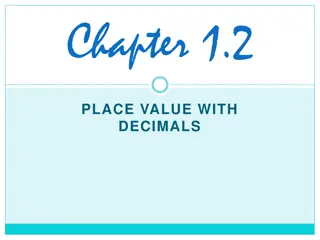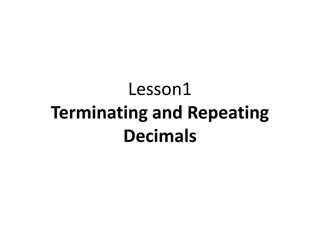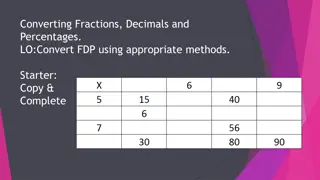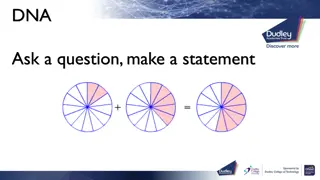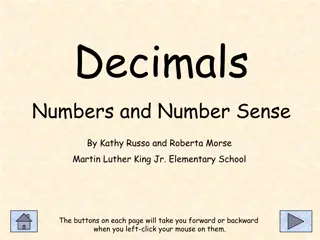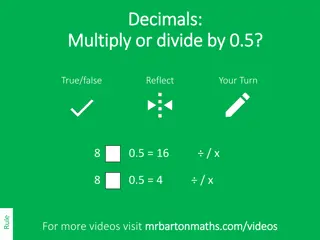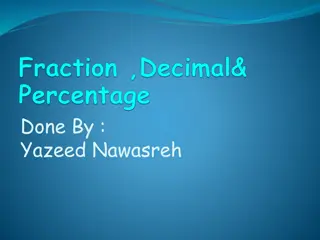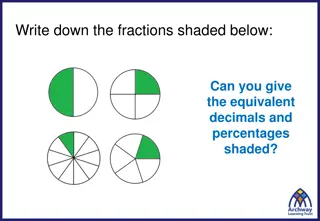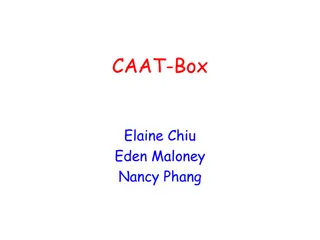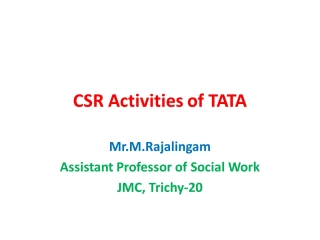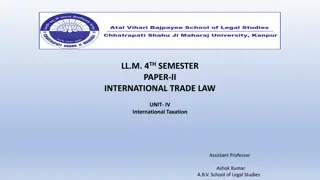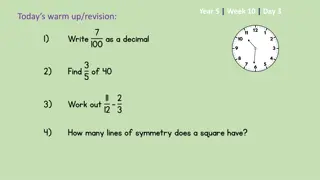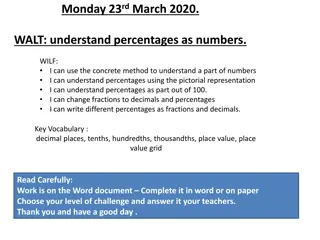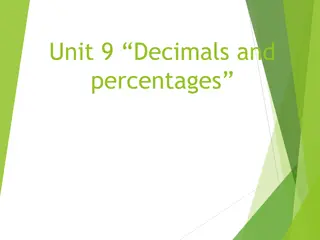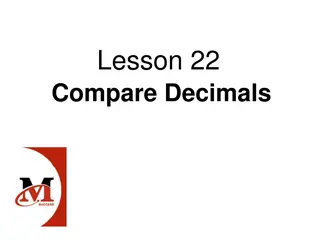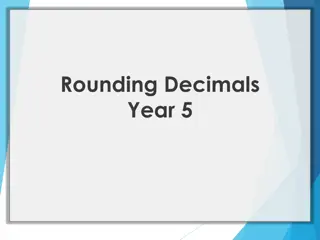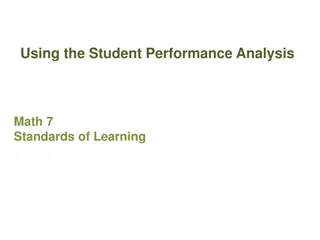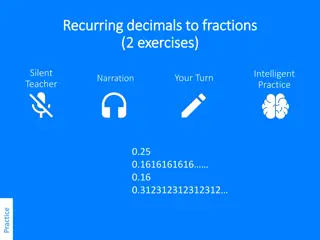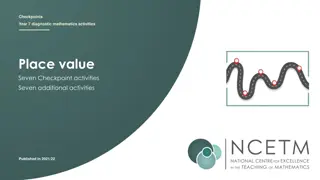Understanding Decimals in Mathematics at Tata DAV Public School, Joda
Exploring the concept of decimals, place value charts, converting fractions to decimals, and the order of decimals in Class V Mathematics at Tata DAV Public School, Joda. Learn about the Hindu-Arabic and International systems of numeration, multiplication and division by 10, and the introduction of tenths in decimal fractions.
Download Presentation

Please find below an Image/Link to download the presentation.
The content on the website is provided AS IS for your information and personal use only. It may not be sold, licensed, or shared on other websites without obtaining consent from the author. Download presentation by click this link. If you encounter any issues during the download, it is possible that the publisher has removed the file from their server.
E N D
Presentation Transcript
DAV INSTITUTIONS ODISHA ZONE-1 Name of the school- TATA DAV PUBLIC SCHOOL, JODA Class- V Subject- Mathematics Topic- Decimals
DECIMALS CONCEPT OF DECIMALS PLACE VALUE CHART DECIMAL PARRT AND WHOLE NUMBER PART CONVERT FRACTION TO DECIMALS EXPANDED FORM OF OF A DECIMAL LIKE AND UNLIKE DECIMALS CONVERTING UNLIKE DECIMALS INTO LIKE DECIMALS ORDERING OF DECIMALS
In the previous chapters we have already studied Hindu-Arabic system of numeration International system of numeration These system of numerations are also known as Decimal system of numeration As we use ten digits to write a number (0,1,2,3,4,5,6,7,8,9)
Can we arrange 4 in place value chart? Yes Hundreds Tens Ones 0 0 4 4 jumps one column to left What happens when 4 is multiplied by 10 ? Hundreds Tens Ones 4 10 =40 0 4 0 4 jumps one column to right What happens when 40 is divided by 10 ? 40 10 = 4 Hundreds Tens Ones 0 0 4 Conclusion- Multiplied by 10 jumps one column to left Divided by 10 jumps one column to right
What happen when we divide 4 by 10 ? But there is no place right to ones Yes .. Jumps one column right We know Hundreds Tens Ones 0 0 4 Hundreds Tens Ones Decimal Tenths Lets add one more column right to ones 0 0 0 . 4 Added new column is called TENTHS in the place value chart. Read as point 4 or decimal four or zero decimal four 4 10 = ? ??= . ? ?? ?.? Since 4 We separate4 10 is a fraction with a value less than 1. 10 by a point called the Decimal point.
NUMBER NAME FRACTION DECIMAL READ AS ZERO POINT THREE 3 10 0.3 THREE TENTHS FIVE AND THREE TENTHS FIVE POINT THREE 53 10 5.3 SIXTEEN AND NINE TENTHS SIXTEEN POINT NINE 169 16.9 10
When 7 is divided by 100, it moves two column right to ones. Its place value becomes- 7 100 = ? ??? = 0.07 = 7 hundredths Tenths (? Hundredths ( Thousands (1000) Hundreds (100) Tens (10) Ones (1) Decimal point (.) ? ??) ???) 0 0 0 0 . 0 7 When 7 is divided by 1000, it moves two column right to ones. Its place value becomes- 7 1000 = ? ???? = 0.007 = 7 thousandths Tenths (? Hundredths ( Thousandths ( Thousands (1000) Hundreds (100) Tens (10) Ones (1) Decimal point (.) ? ? ??) ???) ????) 0 0 0 0 . 0 0 7
NUMBER NAME FRACTION DECIMAL READ AS SIX ZERO POINT ZERO SIX 6 0.06 HUNDREDTHS 100 TWENTY NINE HUNDREDTHS ZERO POINT TEO NINE 29 100 0.29 ZERO POINT ZERO THREE FIVE THIRTY FIVE THOUSANDTHS 35 0.035 1000 SIX AND SEVENTEEN HUNDREDTHS SIXPOINT ONE SEVEN 617 100 6.17
Total number of boxes= 100 Number of boxes with red colour= 26 Fraction representing red colour= 26 Similarly, fraction representing yellow colour= 42 100= 0.26 ( Twenty six hundredths) 100= 0.42 ( Forty two hundredths) 4 100= 0.04 ( Four hundredths) Fraction representing green colour=
DECIMAL PART AND WHOLE NUMBER PART A decimal number consists of two parts- 1. Whole number part 2. Decimal part These two parts are separated by a dot(.) 85 . 036 Whole number part Decimal part While reading a decimal number, the whole number part is read as a whole and the decimal number part in separate digits. Let us read 72.63 = Seventy two point sixty three
WAY TO CONVERT FRACTIONS TO DECIMALS Step 1 : See denominator. It is 100 (No. of zeroes is two) Step 2 : In numerator, count two digits from the right and move towards left, then, put a point(.) Left 0 . 5 8 Right Thus, ?? ???= ?.?? In the same way, 367 1000= 0.367 Count three digits and put a decimal 1000 = 0.027 (Since there are only two digits, we will put a zero and then, a decimal.) 27
EXPANDED FORM OF A DECIMAL 8 5 . 9 3 7 Tens place Ones place Tenths place Hundredths place Thousandths place 5 ones 9 tenths 3 hundredths 8 tens 7 thousandths + + + + ? ? ? 5 80 ??? ?? ???? 85.937 = 8 tens + 5 ones +9 tenths +3 hundredths +7 thousandths = 80 + 5 + 9 1000 3 7 10 + 100 +
Similarly, the expanded form of 624.389 = 6 hundreds + 2 tens + 4 ones + 3 tenths +8 hundredths + 9 thousandths = 600 + 20 + 4 +3 1000 8 7 10 + 100 + 108.039 = 1 hundreds+ 0 tens + 8 ones+ 0 tenths+ 3 hundredths+ 9 thousandths = 100 + 0 + 8 + 0 10+ 3 7 100 + 1000
ACTIVITY TO WRITE EXPANDED FORM OF A DECIMAL NUMBER Click on the link below https://youtu.be/kmGCtKo_52Q
LIKE AND UNLIKE DECIMALS Digits in the decimal part are called Decimal Places. Decimal numbers which have same number of decimal places, are called Like Decimals. Examples of Like Decimals- i) 0.8, 2.5, 13.6, 421.3, 6.9 ii) 1.325, 29.564, 365.987, 0.421, 7.300 Decimal numbers which have different number of decimal places, are called Unlike Decimals. Examples of Unlike Decimals- i) 1.9, 3.65, 41.523 ii) 65.3, 3.698, 0.0025, 1.02
CONVERTING UNLIKE DECIMALS INTO LIKE DECIMALS Let us take a pair of unlike decimals say, 0.4 and 0.785 0.785 0.4 and It has three decimal place It has one decimal place Can We convert unlike decimals into like decimals without changing their values ? How ? Yes.. Adding zeroes to the right of decimal number * 0.785 0.400 (Here two zeroes are placed to the right of 4) Now, 0.785 and 0.400 are like decimals as both have three decimal places. * Adding zeroes to the right of a decimal number does not change its value
ORDERING OF DECIMAL NUMBERS First, we compare the whole number part. 56.8 > 9.52 Then, we compare the digits in the tenths place. 23.695 < 23.83 Next, we compare the digits in the hundredths place. 8.654 > 8.629 Lastly, we compare the digits in the thousandths place. 43.503 < 43.509
APPLICATION OF DECIMALS IN DAILY LIFE + + 20 + 1 + 0.50 = 21.5 = 1500 ml = 1.5 L +
SUMMARY SUMMARY The system of numeration containing 10 digits ( 1,2,3,4,5,6,7,8,9,0 ) is called DECIMAL SYSTEM OF NUMERATION. By multiplying 10 we move to one place left and by dividing 10 we move one place right in a number. Fractions with denominator 10,100,1000 etc are called decimal fractions. Each decimal number has a whole number part as well as a decimal part. While reading a decimal number, the whole number part is read as whole and decimal number part is read as separate digit. Decimal numbers which have same number of decimal places, are called Like Decimals. Decimal numbers which have different number of decimal places, are called Unlike Decimals.
Used to represent tenths, hundredths, thousandths and so on. Ex- ?? = 0.3, ? ???? = 0.007 Decimal System of Numeration Contains 10 digits (1,2,3,4,5,6,7,8,9,0) Having Two parts 5 . 09 Whole number Decimal ? ? ??? = 0.09, Two types of decimal Like decimal (0.85,1.39) Unlike Decimal (1.38, 4.5) In a number Multiply by 10 shifts to left Divide by 10 shifts to right Place DECIMAL DECIMAL Place We can convert unlike decimals to like decimals by adding zeroes to the right of a decimal number. (1.38 and 4.50 are like decimals) Expanded form of a decimal number- 23.96 = 2 tens+ 3 ones+ 9 tenths+ 6 hundredths = 20 + 3 + ? ?? + ? ???


